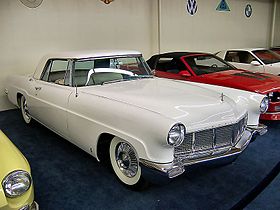Continental Mark II
| Continental Mark II | |
|---|---|

1956 Continental Mark II.
|
|
| Overview | |
| Manufacturer | Continental (Ford) |
| Model years | 1956–1957 |
| Assembly | Wixom Assembly, Wixom, Michigan, United States |
| Designer | John Reinhart |
| Body and chassis | |
| Body style | 2-door hardtop |
| Layout | FR layout |
| Powertrain | |
| Engine | 368 cu in (6.0 L) 4-bbl. Y-block V8 |
| Transmission | Turbo-Drive 3-speed automatic |
| Dimensions | |
| Wheelbase | 126.0 in (3,200 mm) |
| Length | 218.4 in (5,547 mm) |
| Width | 77.5 in (1,968 mm) |
| Height | 56.3 in (1,430 mm) |
| Curb weight | 5,000 lb (2,300 kg) |
| Chronology | |
| Successor | Lincoln Continental Mark III coupe |
The Continental Mark II is a personal luxury car that was produced by the newly created Continental Division of the Ford Motor Company, in 1956 and 1957. An attempt to build a post-World War II car to rival the greatest of the pre-War era, or anything produced in Europe, it is regarded as a rare and elegant classic.
As Lincoln introduced its first post-war model line for the 1949 model year, the division discontinued the Lincoln Continental. Although the V12-powered personal luxury car had gained a positive reputation over its war-interrupted model run, to better ensure its survival, Lincoln sought a role closer to Mercury in the Ford lineup.
By the beginning of the 1950s, with the future of Lincoln more secure, Ford began development work on a fourth division, intended to build the most expensive American car, priced even above Cadillac, Packard, and Imperial. Returning to the 1939-1948 Continental, the new vehicle was not intended to be the largest or most powerful automobile; rather, the most luxurious and elegant American car available, designed to recapture the spirit of the great classics of the prewar period—with prices to match.
Having considered using an outside design team, Ford turned inside to their own Special Products Division. In Fall 1952, they designated John Reinhart as chief stylist; Gordon Buehrig as the chief body engineer, assisted by Robert McGuffey Thomas; and Harley Copp as chief engineer.
Ford had wanted to use unibody technology, but Copp argued against such a choice for a high-brand/low volume model, which was required to be delivered into sale in a short time scale.
What emerged was something quite unlike other American cars of the period. While other makes experimented with flamboyant chrome-laden styling, the Continental Mark II was almost European in its simplicity of line and understated grace.
The new Continental was introduced in October 1955—but not at big American auto shows, such as those in New York and Chicago. Rather it was unveiled at the Paris Auto Show, and later that October at Ford headquarters in Dearborn.
...
Wikipedia
